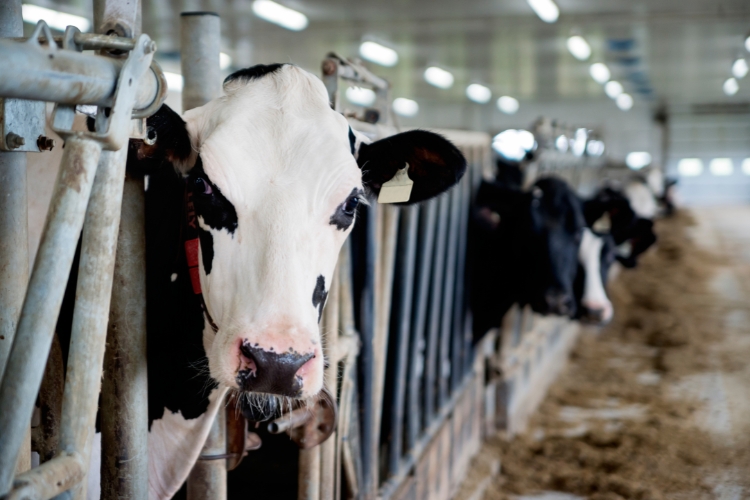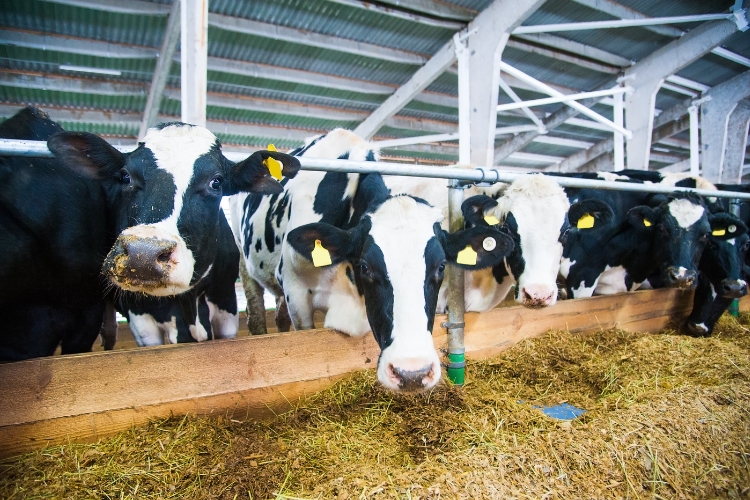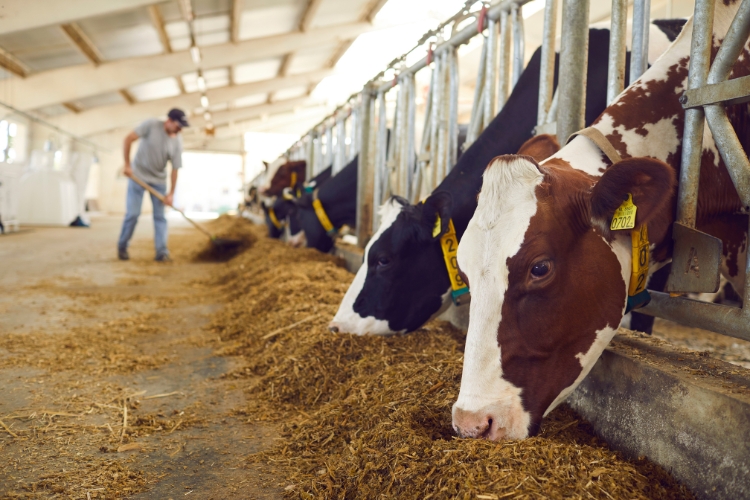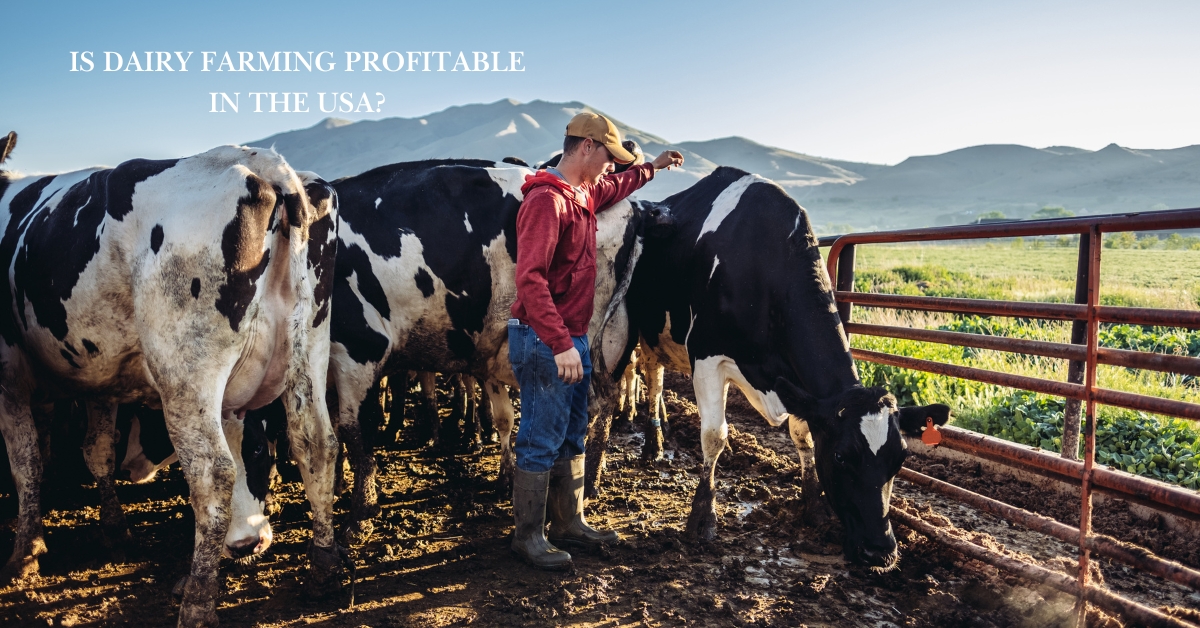Can you make a decent living from dairy farming? This is a question many people are asking as they consider entering the dairy industry.
While dairy farming can be challenging, strategies exist to maximize profitability and create a thriving business.
Dairy farming in the USA can be profitable, but success depends on farmers effectively managing their operations, mitigating risks, and adapting to changing market conditions.
Key Takeaways:
- Dairy farming in the USA can be profitable but requires strategic planning, efficient operations, and careful risk management.
- Understanding market trends, diversifying products, and collaborating with others are key strategies for market success.
- Efficient farm management, including optimizing resources, financial planning, and labor management, is crucial for profitability.
- Proper feed and nutrition management support cow health, productivity, and ultimately, farm profitability.
- Mitigating risks through insurance, strategic financial planning and diversification can help dairy farms navigate uncertainty.
- Embracing technology and innovation can improve efficiency and decision-making on dairy farms.
- Economies of scale favor larger dairy operations, but smaller farms can also be successful through exceptional management and niche strategies.
- Global market dynamics, including trade agreements, tariffs, and global milk production, can significantly impact the US dairy industry.

Market Dynamics: Understanding Demand and Identifying Opportunities
Understanding market trends, consumer preferences, and industry dynamics is essential for making informed production and sales decisions. Farmers who stay informed about market conditions can identify emerging opportunities, assess the demand for different dairy products, and adjust production plans to meet consumer demand.
1. Strategies for Market Success
a. Market Research
- Conduct thorough research to understand the demand for dairy products in your local and international markets.
- Stay updated on industry trends, competitor activity, consumer preferences, and regulatory changes.
- Use customer feedback and data analysis to inform production decisions and market strategies.
b. Diversification
Consider diversifying your dairy farm products to meet evolving market demands and open up new revenue streams. This might include:
- Specialty cheeses
- Organic milk
- A farm store
- A cafe
- Agri-tourism
- On-farm processing
- Farm-stay accommodations
c. Collaboration
Explore collaborations with other farmers, processors, or retailers to create synergies and capture new market opportunities.

Efficient Farm Management: Optimizing Resources for Profitability
Efficient farm management is crucial to maximizing a dairy farm’s performance and profitability. This involves optimizing various aspects of farm operations:
- Crop management
- Herd health
- Financial management
Efficient farm management allows you to make informed decisions, streamline processes, and maximize resources, leading to positive financial results.
1. Essential Practices for Operational Efficiency
a. Budgeting and Financial Planning
- Develop a comprehensive budget and financial plan to manage costs and optimize profits.
- Track expenses, monitor cash flow, and identify areas for cost-saving measures.
b. Livestock Management
- Optimize herd health and reproduction rates through regular veterinary care, nutrition management, and genetic selection.
- Monitor production levels and adjust feed rations accordingly.
c. Resource Management
Optimize the use of natural resources:
- Land
- Water
- Energy
Implement sustainable practices to reduce costs and environmental impact:
- Rotational grazing
- Water recycling
- Energy-efficient equipment
d. Focus on Labor
Evaluate labor management practices:
- Do you have the right staff?
- Are they trained?
- How productive are they?

Feed and Nutrition Management: A Cornerstone of Herd Health and Profitability
Providing a balanced and nutritious diet to cows is essential for their health and productivity. Proper feed and nutrition management supports cow growth, reproduction, and milk production. This can lead to:
- Improved milk quality
- Higher milk yields
- Better reproductive performance, ultimately increasing profitability
Neglecting or mismanaging feed and nutrition can have negative consequences, such as:
- Poor herd health
- Reduced milk production
- Increased veterinary costs, leading to financial losses
1. Strategies for Successful Feed Management
a. Monitoring
- Regularly monitor and analyze feed and nutrition-related costs and performance metrics to identify areas for improvement.
- Monitor feed intake, cow body condition scores, and cow health and behavior to assess their nutritional status.
b. Research
Stay informed about the latest research and advancements in feed and nutrition.
c. Best Practices
- Utilize pasture and forage resources, manage grazing rotations effectively, and implement appropriate supplementation strategies.
- Maintain proper feed storage and handling practices to prevent spoilage and contamination, which can impact feed quality and cow health.
- Provide clean, fresh water.

Risk Management and Strategic Financial Planning: Navigating Uncertainty
Dairy farming is exposed to many risks, including:
- Natural disasters
- Seasonal anomalies
- Economic factors
- Accidents
- Disease
Knowing the risks and insuring yourself against them with adequate coverage, contingency plans, and safety nets helps ensure you can bounce back if the unexpected happens.
1. Key Strategies
a. Insurance
Protect your farm and livestock with appropriate insurance coverage. Choose a policy that suits your farm’s needs, including coverage for:
- Adverse weather
- Disease outbreaks
- Market fluctuations
b. Strategic Financial Management
- Develop a realistic budget and set saving and profit goals.
- Introduce cost-cutting measures like cash flow management, repurposing waste, renegotiating deals with suppliers, and switching to solar.
- Assign KPIs, monitor and analyze financial data regularly, and seek professional financial advice.
c. Diversification
Diversify your income sources to mitigate risks associated with relying solely on milk prices.
d. Emergency Preparedness
Have a contingency plan in place for unforeseen events like natural disasters, disease outbreaks, or supply chain disruptions.

Technology and Innovation: Embracing Advancement for Efficiency
Technological advancements provide opportunities to optimize farm operations and increase efficiency. Consider incorporating the following into your operation:
- Automated Systems: Automated milking systems
- Data-Driven Decision Making: Precision farming technologies and data analysis tools
Continuing Education
Farmers should stay updated with the latest research and developments in the dairy industry. Participate in workshops, seminars, and courses to stay ahead in this ever-evolving industry.

The Economics of Dairy Farming: Scale and Profitability
Economies of scale exist in dairy operations, meaning that larger dairy operations tend to have lower average production costs. These cost advantages result from the ability of larger farms to:
- Utilize equipment and structures more intensively
- Achieve greater labor cost efficiency
1. Profitability Trends
Data from the USDA’s Economic Research Service (ERS) shows that larger dairy farms in the US typically have higher operating profit margins than smaller operations. For example, in 2020:
| Farm Size | Operating Profit Margin |
|---|---|
| Under $100,000 in sales | Negative |
| $500,000 to $999,999 in sales | 6.4% |
| Over $1 million in sales | 18.1% |
This data highlights the economies of scale in dairy operations and suggests a continuing trend toward fewer, larger dairies.
While smaller farms have a cost disadvantage, many factors contribute to a farm’s profitability, and some smaller farms are quite successful. Factors that can help smaller farms remain profitable include:
- Exceptionally good management
- Below-average input prices
- Above-average product prices
Additionally, some smaller farms may choose to operate even if they are not covering all of their costs because they are willing to accept less income than they could earn in nonfarm employment.

Global Market Influences: A Broader Perspective
Global market dynamics can significantly influence US dairy product prices and demand. These dynamics include:
- International trade agreements
- Tariffs
- Global milk production trends
1. Navigating Global Factors
a. Trade Agreements
Trade agreements, such as the USMCA, can create stability and improve access to markets for US dairy products.
b. Tariffs
Tariffs can make US dairy products less competitive in the global marketplace. For instance, trade disputes with China resulted in retaliatory tariffs on US dairy exports, increasing the cost of American goods and hindering export growth.
c. Global Milk Production
Increased milk production in other countries, such as New Zealand and the European Union, can increase competition and put downward pressure on US dairy export prices.
Despite these challenges, opportunities exist for growth in the global dairy market. Expanding middle-class populations and increased dairy product consumption in regions like the Middle East and Southeast Asia represent potential new markets for US dairy products.
Conclusion
Dairy farming in the USA can be profitable, but it requires strategic planning, efficient operations, careful risk management, and a willingness to embrace innovation. The dairy industry is likely to continue consolidating, with larger farms gaining a greater share of production due to economies of scale. However, many smaller farms can remain viable by implementing efficient practices, adapting to changing market dynamics, and capitalizing on niche markets.
Aspiring dairy farmers should thoroughly research market conditions, develop a comprehensive business plan, and carefully consider the economic factors that will influence their success. By focusing on efficiency, innovation, and market responsiveness, dairy farmers can position themselves for success in the US dairy industry.
FAQs:
- Can you make a living from dairy farming in the USA?
Dairy farming in the USA can be profitable, but it requires strategic planning, efficient operations, and careful risk management. Factors like market research, diversification, and effective farm management can help dairy farmers succeed and earn a decent living. - What are the key strategies for dairy farmers to maximize profitability?
Some key strategies for dairy farmers to maximize profitability include conducting thorough market research, diversifying their product offerings, collaborating with others in the industry, optimizing resource use, implementing efficient financial and livestock management practices, and embracing technological advancements. - How do economies of scale impact the profitability of dairy farms in the USA?
Economies of scale in dairy operations mean that larger farms tend to have lower average production costs. This allows larger dairy farms to typically achieve higher operating profit margins compared to smaller operations. However, smaller farms can still be successful through exceptional management, favorable input prices, and targeting niche markets. - What are the global market factors that can influence the profitability of US dairy farms?
Global market dynamics, such as international trade agreements, tariffs, and trends in global milk production, can significantly impact the prices and demand for US dairy products. Navigating these global factors, including exploring new export markets, is crucial for US dairy farmers to remain profitable.

